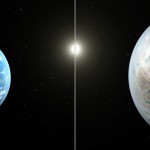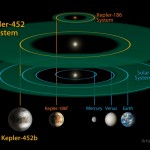W. M. Keck Observatory press release…
The W. M. Keck Observatory has confirmed the first near-Earth-size planet in the “habitable zone” around a sun-like star. This discovery and the introduction of 11 other new small habitable zone candidate planets were originally made by NASA’s Kepler space telescopes and mark another milestone in the journey to finding another “Earth.”

The data from Kepler suggested to the team there was a planet causing the light from it’s host star to dim as is orbited around it. The team then turned to ground-based observatories including the University of Texas at Austin’s McDonald Observatory, the Fred Lawrence Whipple Observatory on Mt. Hopkins, Arizona, and the world’s largest telescopes at Keck Observatory on Maunakea, Hawaii for confirmation.
Specifically, the ten-meter Keck I telescope, fitted with the HIRES instrument was used to confirm the Kepler data as well as to more precisely determine the properties of the star, specifically its temperature, surface gravity and metallicity.
“These fundamental properties are used to determine the stellar mass and radius allowing for precise determination of the planet size,” said Howard Isaacson, researcher in the astronomy department at UC Berkeley and mamba of the discovery team. “With the precise stellar parameters from the HIRES spectrum, we can show that planet radius is closer to the size of the Earth, than say Neptune (~4x Earth’s radius). With a radius of 1.6 times the radius of the Earth, the chances of the planet having some sort of rocky surface is predicted to be ~50%. The Keck Observatory spectrum is also used to rule out false positive scenarios. Background stars can confuses the interpretation of the planet hypothesis, and the Keck Observatory spectrum shows that no such background stars are present.”

Kepler-452b is 60 percent larger than Earth and is considered a super-Earth-size planet. While its mass and composition are not yet determined, previous research suggests that planets the size of Kepler-452b have a good chance of being rocky.
While Kepler-452b is larger than Earth, its 385-day orbit is only 5 percent longer. The planet is 5 percent farther from its parent star Kepler-452 than Earth is from the Sun. Kepler-452 is 6 billion years old, 1.5 billion years older than our sun, has the same temperature, and is 10 percent larger and 20 percent brighter.
The Kepler-452 system is located 1,400 light-years away in the constellation Cygnus. The research paper reporting this finding has been accepted for publication in The Astronomical Journal.
In addition to confirming Kepler-452b, the Kepler team has increased the number of new exoplanet candidates by 521 from their analysis of observations conducted from May 2009 to May 2013, raising the number of planet candidates detected by the Kepler mission to 4,696. Candidates require follow-up observations and analysis to verify they are actual planets.
Twelve of the new planet candidates have diameters between one to two times that of Earth, and orbit in their star’s habitable zone. Of these, nine orbit stars that are similar to our sun in size and temperature. These candidates are likely targets for future observing runs at Keck Observatory for confirmation.
“We’ve been able to fully automate our process of identifying planet candidates, which means we can finally assess every transit signal in the entire Kepler dataset quickly and uniformly,” said Jeff Coughlin, Kepler scientist at the SETI Institute in Mountain View, California, who led the analysis of a new candidate catalog. “This gives astronomers a statistically sound population of planet candidates to accurately determine the number of small, possibly rocky planets like Earth in our Milky Way galaxy.”
These findings, presented in the seventh Kepler Candidate Catalog, will be submitted for publication in the Astrophysical Journal. These findings are derived from data publicly available on the NASA Exoplanet Archive.

